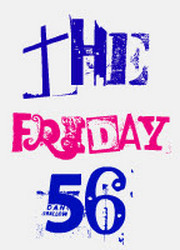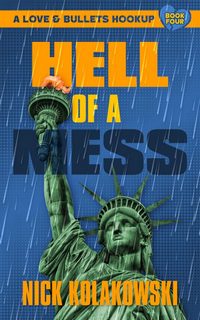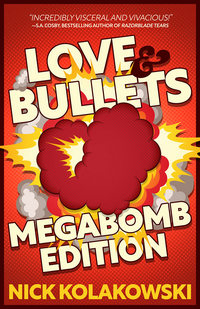He’s back for the sixth time, now to talk about the fourth installment of this Love & Bullets series of hookups, Hell of a Mess (I posted about it earlier today). I look forward to these Q&As a lot, I know that when I get the responses I’ll learn a few things, understand the books better, and will grin at least twice. Not only does he write a good book, he writes a good answer. The novel comes out at the end of the month, get your orders in today!
So what brought you back to Bill and Fiona? Did you get a hankering to do something new with them while putting The Megabomb Edition together or did you get the idea for a heist in a hurricane (or something like that) and decide they’d fit better than someone new?
I’d always wanted to do a heist in a hurricane. When I was a teenager, for reasons I can’t quite explain, I was really into the movie “Hard Rain” with Morgan Freeman and Christian Slater, which centers on an armored truck robbery in a flooded town. It’s a pretty mediocre flick, but I really dug the idea of taking two distinct genres—crime and natural disaster—and slamming them together.
So, the basic framework of heist-in-a-hurricane rattled around in my brain for years. I thought about it more after Hurricane Sandy smashed through New York ten years ago, which came with all the chaos you can imagine—no power, flooded buildings, chaos in the streets. I even wrote some crime-themed short stories that took place during Sandy, but the itch to turn it into a full-fledged novel didn’t grip me until 2020.
Originally, it was supposed to involve all-new characters, but I really like Bill and Fiona, and I thought: why not? I know how they think. I know what they’d do. It seemed more organic to make it another Love & Bullets adventure.
This question might have fit better for the first Love and Bullets novella, but it still applies here. Can you talk a little about your decision to have the unnamed-assassin as your first person narrator rather than one of the protagonists, or a third-person omniscient narrator? He’s important to this novel, and the first novella—but not as important to the rest of the series—but he’s not a John Watson or Nick Caraway kind of non-protagonist narrator, either. Maybe you can describe his function in the series as well (I clearly can’t do it concisely). Also, was leaving him nameless a conscious decision, or just something that happened along the way that you stayed with it?
Leaving him nameless is just something that happened along the way. The assassin is human, obviously, but I also think of him as a supernatural or mythical force—almost like a Loki, a spiritual trickster who’s not firmly implanted in this world. Giving him a name seemed to reduce him somehow, at least in my mind.
I can’t explain why he’s written in the first person, and the other characters are shoved into the omniscient third. Not to give too much agency to a fictional character, but it’s what he wants; when I sit down and write from his perspective, it just spools out effortlessly. When I started Hell of a Mess, I very briefly tried writing him from the same third-person perspective as the other characters, and it simply fell flat.
There was also a version of Hell of a Mess where he didn’t appear at all, and it didn’t work, either. He’s the levity that differentiates the series from other crime fiction, in my mind; he’s the crazy element, the secret sauce, the glue that binds the narratives together on a subtextual level. Maybe that’s because he’s always articulating the book’s themes as he wrestles with his own feelings and coincidence; maybe it’s just that I find him funny as hell.
How do you balance the threat of a hurricane with the various human threats running around this book? Are there special challenges involved in using a natural disaster like this in a book, or is it a gift—allowing a random tree branch or torrent of rain to come along and interrupt things when you want?
It’s a gift and a curse. If you’re jammed up in the plot, yeah, you can send a tree branch or a flood through to shake things up—it’s the nature equivalent of Chandler’s old adage about how if you’re stumped on how to advance the plot, just have someone walk in with a gun. Living through Sandy, I learned firsthand how a big storm can really impact even the most mundane physics; at one point, I had to open a door with another big guy, and it took all of our strength to crack it open even a few inches against the wind and the air pressure. You throw those physics into a fictional narrative, and you generate some really interesting potentials for suspense.
At the same time, especially when you’re using a hurricane, you have to make sure the tempo of the storm aligns with your action—for example, as the storm intensifies, your characters really can’t do anything outside, which is why I decided to have the climax of the book take place just as the eye passes overhead, cutting out the wind and rain.
Let’s take a break from your work for a moment—you’re a reader/viewer as well as a writer, what’re some of the books/movies/shows this year that you’ve been enjoying?
I loved Heat 2. I was lucky enough to get an early copy, and I had some trepidations about how well Michael Mann would carry off that shift from cinematic to novelistic, but I needn’t have worried—the book is fantastic. Meg Gardiner, his co-author, layered it with her trademark suspense, and the whole thing really works.
I’m also reading Jordan Harper’s Last King of California, which is coming out in late September in the UK (although U.S. readers can find a copy via Amazon.co.uk pretty easily, I think). It’s a real treat because Harper is one of the best wordsmiths working the crime genre, and every sentence is rich and thick. The book itself is in the proud tradition of noirs like Blood Father and Tapping the Source, and it’s wonderful.
You’ve got Beach Bodies coming out on Halloween, right? I understand that’s a horror novella? Do you want to give a quick pitch for that one?
Beach Bodies is a super-short horror novella that began as a potential project for a smaller horror publisher, but when that didn’t work, I decided to dip my toe into self-publishing. It’s a weird book with one bloody moment near the end that will probably excite hardcore horror fans while freaking other folks out (one early reader texted me, “DUDE, WTF, LOL,” when she reached it).
The short pitch for it: Julia and Alec are two twentysomethings paid to “house sit” a billionaire’s luxury doomsday bunker on an isolated stretch of beach. Three strangers invade the bunker on a sinister mission, and very bad things happen. There’s a big twist that’ll have you questioning the nature of the characters’ very reality.
As usual, I’ve got to ask, what’s coming down the pike? Are you far enough into your next book(s) to talk about it/them?
Right now I’m working on an episode of A Grifter’s Song, which is a long-running series (something like 28 novellas and counting) written by various crime-fiction authors, including S.A. Cosby, Hilary Davidson, and Paul J. Garth. The series follows two hustlers as they attempt to cheat bad folks out of their money. The main challenge for me is taking these two preexisting characters with a rich backstory established by other authors… and trying not to mess it up.
And by “mess it up,” I mean, “make it too much like Bill and Fiona from Love & Bullets,” which I’m definitely at risk of doing. But I’ll make it work.
Thanks for your time—and thanks for Hell of a Mess—it’s always fun spending time with these characters.
Thank you! I love these questions!

 This is a weekly bloghop hosted by Freda’s Voice.
This is a weekly bloghop hosted by Freda’s Voice. Grab a book, any book.
Grab a book, any book. Turn to Page 56 or 56% on your ereader. If you have to improvise, that is okay.
Turn to Page 56 or 56% on your ereader. If you have to improvise, that is okay. Find a snippet, short and sweet.
Find a snippet, short and sweet. Post it.
Post it.

![]()





